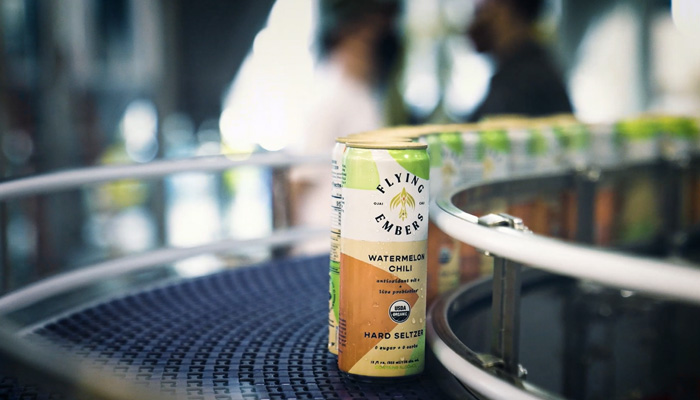
The ready‑to‑drink (RTD) market is booming and projected to grow from about $162 billion in 2024 to over $282 billion by 2034, with a CAGR of ~5.7%. Amid this momentum, lightweight aluminum cans are taking center stage. But why are they dominating, and what else should packaging engineers and brand owners be watching?
RTD Lightweight Aluminum Cans = Eco-Friendly Sustainability Meeting Performance
Aluminum cans for RTD beverages continue to surge in popularity thanks to them being:
- Ultra-light yet durable: Modern cans are engineered to minimize material use without sacrificing strength and are ideal for high-speed filling and shelf drop testing.
- High recyclability: With ~70% + recycling rates in the U.S. and up to 71% recycled content per can, they fit neatly into circular-systems strategies.
- Lower transportation emissions: Their lightweight nature reduces freight-related carbon footprints, a key sustainability metric.
Ready-To-Drink Loves Can Versatility
Cans dominate across RTD categories, from ready-to‑drink cocktails to sparkling waters, coffees, and energy beverages. Water, functional drinks, and RTD coffees attribute their portability, recyclability, and aesthetic appeal to cans.
Alternative Packaging Trends RTD Engineers Should Know
While cans are surging, other formats are rising too:
Aseptic cartons & cartons alternative
Cartons offer lightweight, aseptic packaging, especially appealing amid tariff-driven cost pressures .
Flexible materials & paper-based formats
According to PMMI, paper and flexible pouches are rapidly growing: +43% % for paper, +30% % for flexibles by recent forecasts. These formats are ideal for innovative RTD combinations, including multipacks and seasonal flavors.
Lightweight and recycled glass
Premium and sustainability markets are turning to lightweight glass bottles—lower transport emissions, easily recyclable, and reusable.
Smart Packaging & Consumer Transparency
QR codes on packaging are becoming increasingly popular, as nearly 80% of potential buyers say they’d choose products offering scannable insight into sourcing, sustainability, or nutrition.
Looking further ahead, active and intelligent packaging is emerging, ranging from freshness-monitoring films to battery-free, NFC-enabled sensors that could transform food/beverage safety and shelf-life.
Minimalist & Premium Design Aesthetics
Brands are embracing clean, minimalist designs to signal high quality and sustainability, such as simple labels, bold type, and honest materials. These aesthetics align with consumer preferences for transparency and genuine branding .
RTD Packaging Equipment Implications
With SKUs multiplying and formats diversifying, packaging lines must match pace. PMMI notes top needs in filling, capping, conveying, palletizing, and labeling systems—62% planning filling upgrades, 51% conveying, and 46% labeling investments to support agility.
Final Takeaways
| Trend | Implication |
| Aluminum cans | Maintain agile sourcing and sustainability messaging |
| Cartons & pouches | Upgrade aseptic and flexible packaging capabilities |
| Lightweight glass | Explore for premium RTDs with reusability value |
| Smart/active packaging | Track emerging standards and pilot sensor-enabled formats |
| Design minimalism | Align graphics with brand values and scanning integration |
| Equipment flexibility | Invest in modular lines for multi-format efficiency |
Looking Ahead
The RTD packaging landscape is evolving fast. Aluminum cans currently lead, driven by recyclability, light weight, and ease of use. Yet, pressure from tariff shifts, sustainability demands, and consumer preferences is accelerating interest in cartons, flexibles, glass, and smart packaging. For packaging and process teams, the message is clear: invest in flexible, modular lines capable of pivoting between formats while keeping sustainability and consumer engagement at the forefront.
By embracing a multi-pronged approach, and combining lightweight can agility with emerging alternative and intelligent systems, brands and engineers can future‑proof their RTD strategies for growth and resilience.
Sources
- U.S. Beverage Packaging Market Statistics (2025–2034) – Market size, CAGR, and can growth trends.
Statifacts: U.S. Beverage Packaging Market – 2025 to 2034 nypost.com+12statifacts.com+12towardspackaging.com+12 - Recycled Aluminum Cans Market Forecast – Growth from US $3.73 bn in 2024 to US $5.90 bn by 2034, highlighting recyclability gains.
GlobeNewswire: Recycled Aluminum Cans Market Size globenewswire.com - Trump’s Metal Tariffs Impacting Cans & Cartons – Reuters coverage on new steel & aluminum duties influencing packaging choices.
Reuters: From cans to cartons: how Trump’s metals duties affect packages on shelves towardspackaging.com+12bnnbloomberg.ca+12economictimes.indiatimes.com+12 - Flexible/Recycling Packaging Market Outlook – Pouch and flexible format growth indicators.
Towardspackaging: Recycling Flexible Packaging Market Insights for 2034 futuremarketinsights.com+9towardspackaging.com+9towardspackaging.com+9 - Can Packaging Market Forecast (2024–2034) – Market size valued at US $55.5 bn in 2024, with ~4.8% CAGR through 2034.
Signals: Can Packaging Market Size, Share & Forecasts 2034 towardspackaging.com+7gminsights.com+7towardspackaging.com+7 - Global Beverage Packaging Market Outlook – From US $168 bn (2024) to US $275 bn (2034), ~5.05% CAGR.
Towardspackaging: Beverage Packaging Market Leads USD 275.09 Bn by 2034 statifacts.com+3towardspackaging.com+3towardspackaging.com+3 - Metal Tariff Effects on Packaging – Bloomberg/New York Post highlighting how tariff hikes may push brands away from cans.
NY Post: Canned foods could rise by as much as 30 cents apiece due to Trump’s tariffs on steel reuters.com

